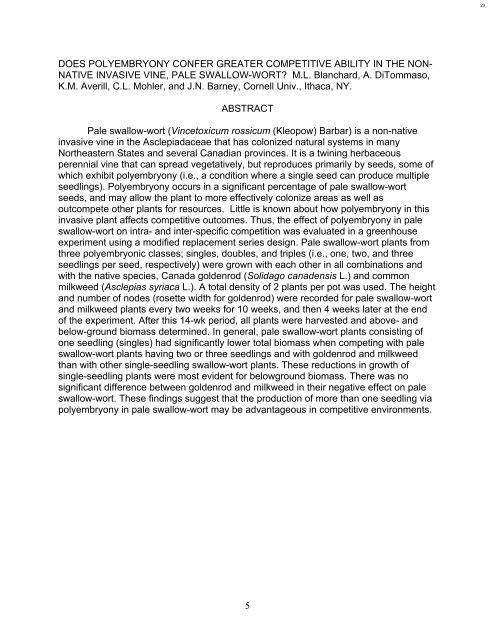Proceedings of the Sixty-first Annual Meeting of the Northeastern ...
Proceedings of the Sixty-first Annual Meeting of the Northeastern ...
Proceedings of the Sixty-first Annual Meeting of the Northeastern ...
You also want an ePaper? Increase the reach of your titles
YUMPU automatically turns print PDFs into web optimized ePapers that Google loves.
23<br />
DOES POLYEMBRYONY CONFER GREATER COMPETITIVE ABILITY IN THE NON-<br />
NATIVE INVASIVE VINE, PALE SWALLOW-WORT? M.L. Blanchard, A. DiTommaso,<br />
K.M. Averill, C.L. Mohler, and J.N. Barney, Cornell Univ., Ithaca, NY.<br />
ABSTRACT<br />
Pale swallow-wort (Vincetoxicum rossicum (Kleopow) Barbar) is a non-native<br />
invasive vine in <strong>the</strong> Asclepiadaceae that has colonized natural systems in many<br />
Nor<strong>the</strong>astern States and several Canadian provinces. It is a twining herbaceous<br />
perennial vine that can spread vegetatively, but reproduces primarily by seeds, some <strong>of</strong><br />
which exhibit polyembryony (i.e., a condition where a single seed can produce multiple<br />
seedlings). Polyembryony occurs in a significant percentage <strong>of</strong> pale swallow-wort<br />
seeds, and may allow <strong>the</strong> plant to more effectively colonize areas as well as<br />
outcompete o<strong>the</strong>r plants for resources. Little is known about how polyembryony in this<br />
invasive plant affects competitive outcomes. Thus, <strong>the</strong> effect <strong>of</strong> polyembryony in pale<br />
swallow-wort on intra- and inter-specific competition was evaluated in a greenhouse<br />
experiment using a modified replacement series design. Pale swallow-wort plants from<br />
three polyembryonic classes; singles, doubles, and triples (i.e., one, two, and three<br />
seedlings per seed, respectively) were grown with each o<strong>the</strong>r in all combinations and<br />
with <strong>the</strong> native species, Canada goldenrod (Solidago canadensis L.) and common<br />
milkweed (Asclepias syriaca L.). A total density <strong>of</strong> 2 plants per pot was used. The height<br />
and number <strong>of</strong> nodes (rosette width for goldenrod) were recorded for pale swallow-wort<br />
and milkweed plants every two weeks for 10 weeks, and <strong>the</strong>n 4 weeks later at <strong>the</strong> end<br />
<strong>of</strong> <strong>the</strong> experiment. After this 14-wk period, all plants were harvested and above- and<br />
below-ground biomass determined. In general, pale swallow-wort plants consisting <strong>of</strong><br />
one seedling (singles) had significantly lower total biomass when competing with pale<br />
swallow-wort plants having two or three seedlings and with goldenrod and milkweed<br />
than with o<strong>the</strong>r single-seedling swallow-wort plants. These reductions in growth <strong>of</strong><br />
single-seedling plants were most evident for belowground biomass. There was no<br />
significant difference between goldenrod and milkweed in <strong>the</strong>ir negative effect on pale<br />
swallow-wort. These findings suggest that <strong>the</strong> production <strong>of</strong> more than one seedling via<br />
polyembryony in pale swallow-wort may be advantageous in competitive environments.<br />
5
















